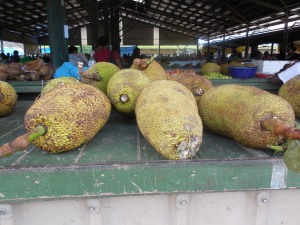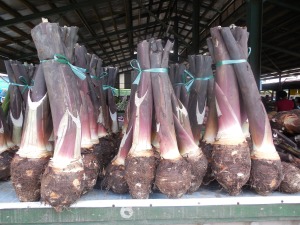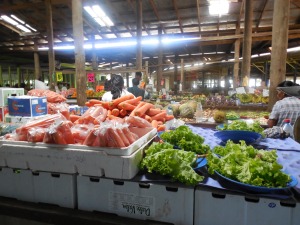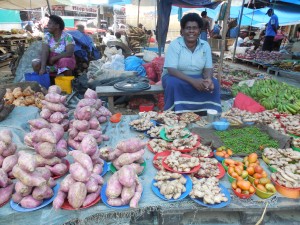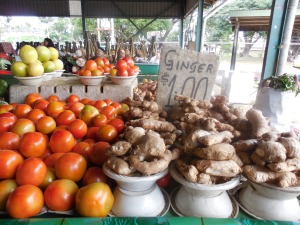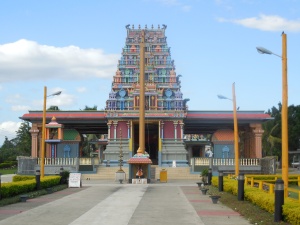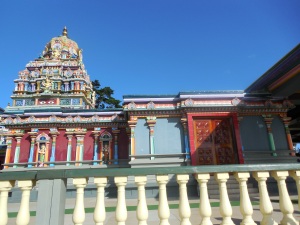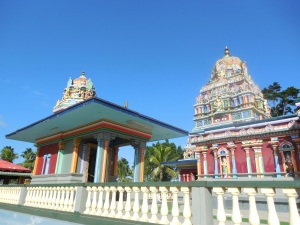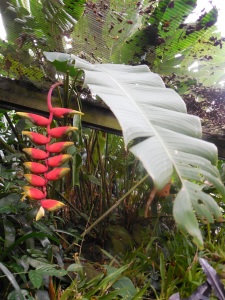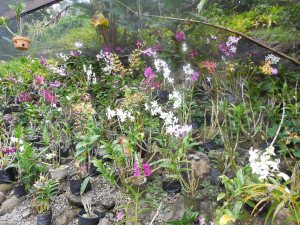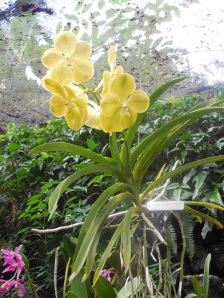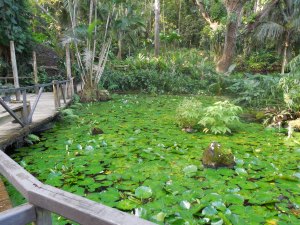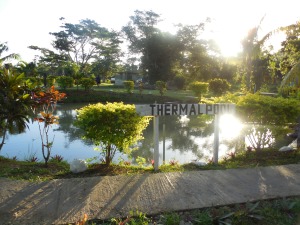Wednesday afternoon was our first group venture to explore Fijian culture. Heading back to downtown Nadi, we stopped at Nadi Municipal Market, a daily-run (except for Sundays) marketplace where farmers bring in their crops for sale and city folk and villagers come by to buy them. Merchants are friendly and, after asking for approval first, are okay with you taking a picture of them at their spots or stalls.
While exploring the market, you get to see and learn a lot about the fruits and vegetables that are staples in the Fijian diet. There is also similar produce to what we have at home.
Taro, a stout and starchy root vegetable, tastes close to a potato is found here in stalk bunches. Jackfruit, another common Fijian produce, reminds me of a watermelon due to its green rind and shape. Tomatoes, ginger, chilies, yams, green beans, carrots, plantains and pineapples are also found here. Also, kava, the roots from a peppery plant used in making kava, the liquid drink, can be bought.
In addition to fruits and vegetables, spices such as cumin, mustard and fennel seeds, cinnamon, and anise stars, are also sold from booths. There is also a fish market on the premises, selling recent catches (my guide tells me it’s better to get fresh fish straight from fisheries) such as, surprising to me, barracuda.
Sri Siva Subrahmaniya Swami Temple
Also with culture, Fiji has an Indian population dating back to when Indian labors were brought to Fiji by the British in the late 1800s (Fiji had been colonized from 1874 until the late 1970s) to work on sugarcane plantations. Our next stop was at the Sri Siva Subrahmaniya Swami Temple, a colorful house of worship erected in 1994 by skilled workers flown in from India.
This South Indian-style temple is built in dedication to Muruga, a mythical general, and is graced with an array of basic colors with intricate patterns. Visitors can explore the temple and its grounds for a small admission price but they are required to remove their shoes before entering. You also have to cover your bare shoulders and legs with a sulu (a wrap skirt).
Garden of the Sleeping Giant
Most people might remember the late actor Raymond Burr for his role as Perry Mason, but he has ties to Fiji, living here. In 1977, Burr established a garden to house orchids that is now known today as “Garden of the Sleeping Giant,” because of it being in a mountain region called the same name.
Located four miles north of Nadi Airport, this garden is said to hold Fiji’s largest orchid collection. Walking through this garden, you’ll catch various species with different shapes, sizes and colors (there is one that looks like toucans), along with other unique and lovely tropical plants.
The garden doesn’t stop at orchids. In fact, you can follow along a path that leads you to a shady region that is like stepping into a Garden of Eden. A guide accompanies you along this walk, pointing out and giving descriptions on various plants, and the path winds along near a leaf pond and ends near a rustic fixture used for ceremonies. You also get a closer look at the mountains.
Sabeto Mud Pool and Hot Spring
We ended our outing at the Sabeto Mud Pool and Hot Spring, located halfway between Nadi and Lautoka. Here we had two options: having a mud bath, by being coated in mud (with minerals good for the skin) and then rising off in a hot spring, a Fijian massage and then also a rinse, or doing both. After you complete your choice, you take a tip in a hot spring to rinse off. I decided on getting a massage.
Our group will soon get going to the Pacific Coast, to get to our next place of stay by motorboat! But first, we will be staying on Denerau Island most of the day to learn more about Fijian cuisine, by cooking it.

